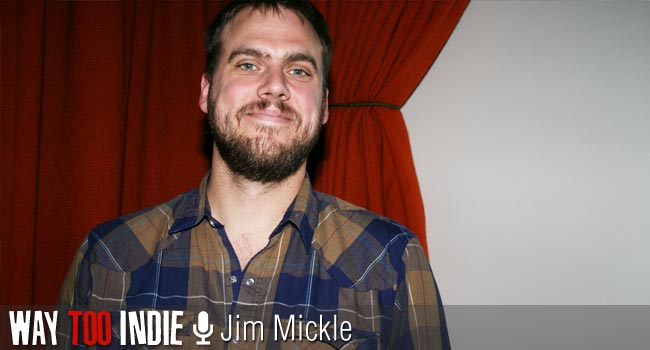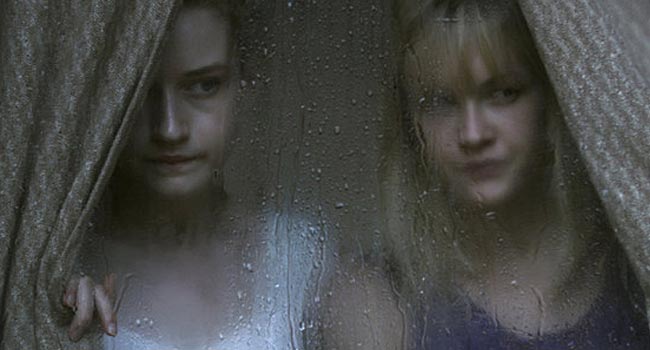Interview: Jim Mickle of We Are What We Are

After directing Stakeland and Mulberry Street, two indie horror films that are slowly building cult followings, director Jim Mickle is back with his third film, We Are What We Are (a remake of Jorge Michel Grau’s 2010 film of the same name). A more somber, calculated breed of scare cinema, it stars Bill Sage as the patriarch of a family of flesh-eaters–Julia Garner (Martha Marcy May Marlene) and Ambyr Childers (The Master) play his lovely daughters–and explores the darkest side of fundamental religion (parabolically, of course), all leading up to a revolting, hurl-inducing finale that’ll have everyone who sees it talking for days.
We spoke to Mickle about being upfront about the cannibalism aspect of the story, being liberated by the fact that it’s a remake, what scares him more; cannibalism or religion, making French people angry, and more.
How’s it been touring with the movie?
It’s good. It’s crazy. You make a movie, you get it all out and you want to tell people about it, and you can’t! You go to a festival and you sit on it for six months. All of a sudden, it’s a year later and it’s like, “Talk about that movie again!” I have this weird relationship with it now, like a distance to it, which I guess is good. I guess it’s healthy.
Are you familiar with Hitchcock’s definition of suspense versus surprise?
Yeah. The bomb under the table.
You show the bomb under the table. You tell us very early in the movie that this is a family of cannibals.
I used that example many times with Nick [Damici], the screenwriter. We would talk about that a lot. “Okay, great. We’ve got this [cannibal thing], now let’s play with that.” It was really fun to go into a movie and, whether we said it or not, people are going to come into it knowing it’s a remake of a film. By the time I heard about the original We Are What We Are, I knew it was a “family of cannibals” movie. So, people are going to come into this knowing. It was really cool to say, “Look. We don’t have to worry about when we drop the hammer.” It’s not like The Crying Game where the last scene is like, “Hey!” It was cool to do that because then the issue wasn’t “What are they?” The issue was, “How does it work?” Why are these pretty girls running around with floral prints? We let that be the suspense of how it was going to play out.
So that’s what it freed you up to focus on.
Yeah, totally. To me, it’s not about the cannibalism. It’s not that they’re cannibals. The family tradition is the horror. That’s also what was fun about it, to say, “They’re cannibals, but it’s not a cannibal movie.” It’s more of a condemnation of fundamental religion.
What’s interesting to me is, this is a remake of a recently released film, but you seem to be liberated by that as opposed to tackling the pressures inherent in a project like this. You don’t seem to be concerned with those pressures one bit.
What was cool was using it like a springboard to do another story and not feel beholden to do his film. Not because we didn’t like it, but because it would be completely redundant. His movie was great; he set out to do a certain thing and he did it. It’s got his voice, his style, and it deals with really interesting themes. It was like, what would you do if you made a remake of this? There’d be nothing there, you know?
It’d be unnecessary.
Which is what most remakes are. It became a cool challenge of, let’s make an original movie that can play by his rules.
When I see filmmakers tackle remakes like this, especially of recent movies, they seem to be a little competitive. Like, “If we’re going to do this, we have to make it bigger and better.” You go the other direction. You don’t even want to think about competing with the original.
Totally. In my last film, Stakeland, we came up with this idea that we were going to do a web series that was going to take each character and was going to have its own universe. We came up with concepts for each character, what their life was like before this apocalypse happened. At some point, we got bogged down and didn’t have the time or the ability to do it. We thought, let’s grab five filmmakers that we really like, who are friends of ours, and say, “This is your challenge. You can see the film, you can see what we did. But now, with your own voice…make a short film with our character.” It’s almost like an artist guest appearing in a comic book series. For us, it was this liberating, awesome experience. There was no sense of competition, just this beauty of storytelling. If someone came to me wanting to make my film, I would want it to be in that spirit as well. I think Jorge kind of got that. He said, “I like your movie. I’m working on my own movie, so I don’t have time to be involved if you wanted me to be involved, so go make it, and I can’t wait to see it!” He got to see it, and I think he really liked it.

What scares you more; cannibalism or organized religion?
Organized religion, by far.
That was a quick answer! Did you try to feed that animal to generate horror in the film?
You find it as you go. Every time you do a little polish or a little pass or a draft, you start to iron these things out. We never set out and said, “We’re to make a movie about a family of cannibals with two girls in it and it’s going to be a parable of Mormonism.” Those things happen, but you never really start out doing them. You explore it, you get lost in it, and you talk about what matters to you. It’s almost like holding a mirror up, like a kind of therapy. But, when you ask me point blank…yeah, organized religion scares me more than any of that stuff.
What’s a great horror movie that explores the theme of religion?
Rosemary’s Baby. There are a lot of parallels with that movie and this one, and it was a big inspiration. These girls feel like they could be some sort of weird descendants of Mia Farrow, in a way. Martha Marcy May Marlene. I just love that movie.
Some of your crew worked on Martha, right?
A whole bunch of them did, actually. Julie [Garner] is in it, one of our producers is from that movie, we have the same script supervisor, hair stylist…
You can feel some of the same sensibilities from Martha in your film, like the use of silent beats. What do you like about quiet moments?
We’d done two movies that are very rich and filled with elements. Seldom is there a quiet moment. When there is one, it pops because there’s been so much music and sound effects. Both of those movies are very motivated by external conflicts. Monsters, creatures. After doing two movies like that, I found that my favorite parts were the dramatic scenes. I wanted to do a whole movie of just that, really. I think it was that, Martha, and a bit of Japanese horror, which I’m enamored with. I love the confidence of those filmmakers to be able to make things creepy in a way that you wouldn’t expect. Those films are unsettling and weird, but they don’t try to jump scare you. It’s the visual storytelling. We wanted something where, because we weren’t giving you certain information, it was going to engage you more, as opposed to filling you up with story and plot twists. We also subverted as much as we could and let it play beautiful and classical.
Talk about the Amish-like clothes the characters wear. Does that stuff creep you out?
Yeah, totally, but it’s also weirdly comforting, too. I grew up around Amish communities.
Where’d you grow up?
Outside of Redding, Pennsylvania, kind of near Lancaster. Not so much now, but growing up there was a bit of an element of Pennsylvania Dutch and this sense of tradition in a lot of people. There’s something about that that’s very comforting. That’s what we play with here–something that’s really comforting can also be corrupted to be something very wrong.
Was the rain in the film real?
No, it was all fake! (laughs) Every shot that has rain in it is fake, except someone corrected me the other day. It actually rained on the first day of the shoot, where we did all the 1780’s stuff. It poured that day, and we put tents outside the cave to block it so we wouldn’t see the rain. It was so funny because it wasn’t supposed to rain for that scene, and then we cut to the rest of the movie where it rains and we had to fake it for every shot.
You’ve traveled with the film for a while now. What’s the most memorable reaction by an audience member to the big finale?
It was at the Deauville Film Festival about three weeks ago. The film was playing with Fruitvale Station and Ain’t Them Bodies Saints. It was a crowd of about 1,500 people, and everyone who goes to it is expecting the next Sundance thing that’s going to go on and win Oscars, the next Fox Searchlight thing, or whatever the hell Sam Rockwell’s in that year. I don’t know if they’ve ever programmed a horror movie there, and the audience just went in blindly. It was all these really bourgeois French filmgoers, probably none of them under the age of 50, and all of them with these salmon-colored sweaters tied around their shoulders. I think we flew in that morning, and I was beat. We had just wrapped another film. I had slept for maybe four hours, got on a plane to France, and all of a sudden we were being ushered to this matinee screening of our film. As soon as the ending happened, people started booing and hissing and yelling. “Out with the director! F the director! This isn’t cinema!” Everybody’s screaming, making a show, violently walking by and making hand gestures to me. The rest of the audience applauded for those people to leave and then gave us a standing ovation. We went out in the lobby, and there were people waiting for us, yelling, “Scandal! Scandal!” We were told, “Now let’s go to the press conference.” And we were like, “Press conference?!” The journalists were arguing in the audience! They were arguing with each other and storming out of the press conference. It was insane. I loved it.
What a perfect response. You pushed right past the boundaries.
People would come up to us three days later when we were walking around town, and people were like, “That’s my favorite movie of the year! Thank you for making it.” Other people would give us the evil eye as we passed. That’s what I wanted to do with the movie. It was the perfect response.
